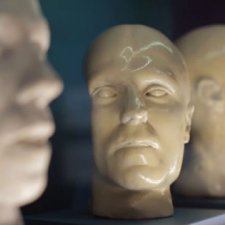Many famous death masks have been taken of the great and the good. People like Beethoven, people like Napoleon, and then also of criminals. So in a sense they are a marker of this person that is left behind, something that can be analysed and studied.
The process of taking a death mask involved shaving the head, so quite soon after the death, involved putting oil onto the skin and the hair to avoid adhesion, and the plaster would have been applied to the front, and then the back would have been taken. And then those two halves are put together to create the mould.
They really acquired great popularity within the 18th century with physiognomy, and then the 19th century with the practice of phrenology.
Phrenology was a practice that was invented more or less by a German physician at the end of the 18th century, an man called Franz Josef Gall. The principle was that you could judge a person's intellect and character from the shape of their head. The brain itself was divided up into different parts that perform different functions, ranging from love of offspring to tendency to be destructive, violent, to how you relate to God, to how you perceive colour and shape, to your love of beauty.
The principle was that because the brain pushed against the skull as a person grew up that therefore the skull perfectly replicated the shape of the brain. So by palpating the skull you could understand more about the inner workings of the individual.
But if you can't get the real thing then death masks were something that you could use to demonstrate to the audience that the pronounced qualities of people, whether they were the great and the good, or the criminal. There is a sense that they can teach us moral lessons, that can show us what evil looks like, playing into this enduring fascination with I guess monsters and deviants in our society.
I mean we think of just the pseudo science now, but it really was a science at the time. It was seriously debated by men of medicine, by philosophers. But phrenologists were also by and large opposed to capital punishment, because they saw phrenology as a reform science. There was this sense among phrenologists, the practicing popular performers who also often great political agitators, that had they been allowed to see Ned Kelly as a child , they might have been able to take steps to rectify these qualities that end up becoming so pronounced later in time.







